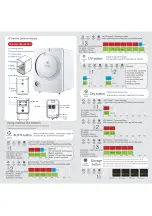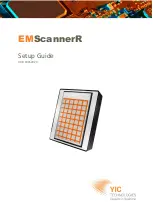
AMBE-2000™ Vocoder Chip Users Manual
Version 4.92, June, 08
DVSI Confidential Proprietary, Subject to Change
Page 48
Visit us at
www.dvsinc.com
Method 2 - Extended Slip Control with Periodic Slip Control Packets
The AMBE-2020™ can provide extended slip compensation through the insertion of Slip Control Packets. One method of
using this capability is for the system to periodically insert these Slip Control Packets into the data stream sent to the
AMBE-2020™. Note that for this method slip control must be enabled (SLIP_EN is high) on the chip. This approach gives
the designer a way to accommodate clock drift while providing very flexible frame-interval and sample-rate timing.
Furthermore minimal system overhead is required. In this method a Slip Control Packet is generated by the system by
setting the Control Words as shown in Table 7D above, where the Channel Data is the compressed voice data being sent to
the AMBE decoder. In the Periodic Slip Control method such a Slip Control Packet is input into the vocoder chip every N
frames. The value of N must be selected by the design engineer to meet the following constraint:
0.25 > (1/N) > Average-Frame-Interval * Sample-Rate * (Frame-Drift + Sample-Drift)
For example with an Average-Frame-Interval = .02 (i.e. 20 ms) and a Sample-Rate = 8000, then with 100 parts per million
oscillator accuracy (i.e. Frame-Drift = Sample-Drift = .0001), then above constraint equates to 4 < N < 31.25, and N=30
would be a reasonable selection. In this case the system would input the specified Slip Control Packet into the AMBE-20X0
vocoder chip every 30’th frame enabling the vocoder chip to adjust for the actual clock drift.
***RECOMMENDED***
Method 3 - Extended Slip Control with as needed Slip Control Packets
The preferred method for using Slip Control Packets is to monitor the availability of data from the AMBE-2020™ vocoder
chip and to only input Slip Control Packets into the data stream sent to the AMBE-2020™ as needed. Note that for this
method slip control must be enabled (SLIP_EN is high) on the chip. This method provides compensation for the widest
range of clock drift (1.2% or 12000 ppm), with the greatest flexibility in frame-interval and sample-rate timing. In this
method the same Slip Control Packets shown in Table 7D are inserted into the data stream going to the AMBE-2020™.
However, unlike in the Periodic method, the packets are not input at regular intervals but are instead only input to the chip
when needed. The recommended procedure for this Method of Slip Control is for the system to read a packet from the
AMBE-2020™ at regular fixed frame intervals where the fixed interval must be within the range [19.875 – 20.125] ms for a
sample rate = 8000 Hz. The system application should check each word output by the AMBE-2020™ and should continue
requesting words from the chip until the packet Header followed by 23 data words are received. If the words received
before the Header word consist of only a single termination word (0xfffe) then no further action is required. However if two
or more termination words are received prior to the Header then the system should input a Slip Control Packet to the
AMBE-2020™ on the next available transmission into the chip (i.e. the next packet going into the AMBE-2020™ decoder
should be a Slip Control Packet). Once this Slip Control Packet is input into the AMBE-2020™ it will respond within 1-2
frames by advancing the time when packets are ready for transmission by 125 microseconds. Note that this procedure also
may require a small amount of buffering in the system to account for the fact that the packet my not be ready for some small
time (< 125 microseconds) after it is first requested.
















































